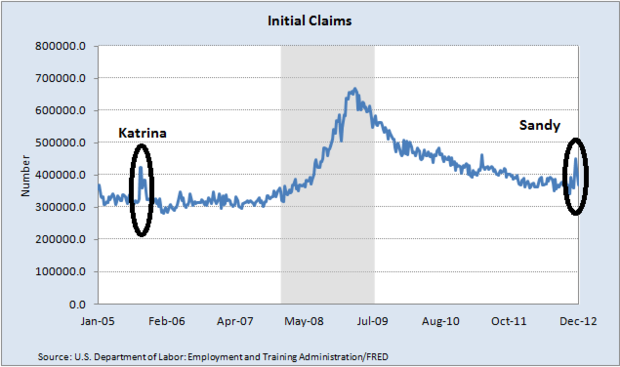November jobs report: Sandy impact muted
(MoneyWatch) The U.S. economy added 146,000 new jobs in November and the employment rate slid to 7.7 percent from last month's reading of 7.9 percent. The results were far better than expected. The Labor Department noted that while Superstorm Sandy caused severe damage in the Northeast, the "survey response rates in the affected states were within normal ranges. Our analysis suggests that Hurricane Sandy did not substantively impact the national employment and unemployment estimates for November."
Using weekly jobless claims as a guide, economists were bracing for a tepid job creation number. The number of people filing new claims for unemployment insurance benefits soared to 451,000 the first week of November, up from an average of 372,000 the previous four weeks. But in the most recent report, the Labor Department said 370,000 people filed new jobless claims last week.
The weekly gyrations echo what occurred to initial claims after Hurricane Katrina. While Katrina was a larger storm, Sandy struck an area with a much denser population, so the impact on employment might be similar. The volatile weekly data spiked then returned to pre-storm trends within two months.
One area where Sandy's impact may have affected the numbers is in unemployment rate. From time to time, there can be a disconnect between the household survey, which is used to calculate the unemployment rate, and the survey of businesses, which determines the number of jobs added or lost for the month. The two reports often move in tandem, but can move in opposite directions, especially in months where there are big seasonal issues at play.
Both surveys are usually conducted based on data from the week of the 12th of the month. For November, the government moved up the household survey by a week to avoid conflicting with Thanksgiving, while the business survey occurred in its regularly scheduled week. That means the household survey was conducted during the immediate aftermath of the storm and many of the respondents could easily have said that they were not "actively looking for work." According to Paul Ashworth, Chief US Economist at Capital Economics "Despite the BLS dismissing the impact of Sandy on payrolls, it was notable that, according to the household survey, 369,000 people couldn't work because of the weather last month, compared with about 64,000 in a normal November."
Maybe some folks would have taken a break from looking for a job, regardless of weather, but the labor force drop of 350,000 meant the participation rate edged 0.2 percent lower to 63.6 percent. As a result, the unemployment rate fell to a near five-year low of 7.7 percent. While it can be tempting to cheer about a lower unemployment rate, this time around, it was for the wrong reason.
What would any discussion about the economy be without a mention of the so-called "fiscal cliff"? Recent surveys indicate that uncertainty over the fiscal negotiations has put a wrinkle in corporate planning and future initiatives. Many companies are waiting to see the final deal on taxes and government spending cuts before allocating capital to new projects or embarking on more robust hiring levels.
Fiscal cliff notwithstanding, the U.S. economy is likely to remain in slow-growth mode well into 2013, a condition that has persisted for almost two years. So far this year, the economy has added an average of 151,000 per month, just slightly ahead of the 2011 pace of 153,000. And as long annual growth is stuck well below 3 percent, the economy will struggle to create the hundreds of thousands of jobs per month required to dramatically lower unemployment.
Unfortunately, many are predicting that 2013 could be the third consecutive year of sub-par growth. According to JPMorgan the expiration of the payroll tax holiday "will reduce U.S. disposable income by $125 billion" which would be a drag on consumer spending and could reduce GDP growth by over half of a percent next year. When the economy is only growing by 2 percent, a one-half reduction is significant.
November jobs:
Jobs created: +146K (Oct: +138K from +171K, Sep: +132K from +148K)
-- Private jobs created: +147K
-- Government jobs lost: -1K
-- Unemployment rate: 7.7% (from 7.9%)
-- Broad unemployment rate: 14.4% (includes the official rate plus "marginally attached workers," those who are neither working nor looking for work, but say they want a job and have looked for work recently; and people who are employed part-time for economic reasons, meaning they want full-time work but took a part-time schedule instead because that's all they could find)
-- Total unemployed: 12 million (from 12.3 million)
-- Long-term unemployed: 4.8 million, representing 40.1 percent of the total unemployed
-- Average duration of unemployment: 40 weeks
-- Participation rate: 63.6 (below the 66% to 67% rate that was normal over the last 20 years; 2/3 of recent decline is due to demographics)
-- Average work week: 34.4
-- Hourly earnings: $23.63 (Over the past 12 months, up 1.7%)
-- Retail: +53K
-- Professional and business services: +43K
-- Health services: +20K
-- Leisure/Hospitality: +23K
-- Construction: -20K (could be Sandy-related)
Editor's note: CBS MoneyWatch initially published an Associated Press story on the unemployment report, which we have since replaced with this staff-written article. You can find the initial AP report and reader comments here.
